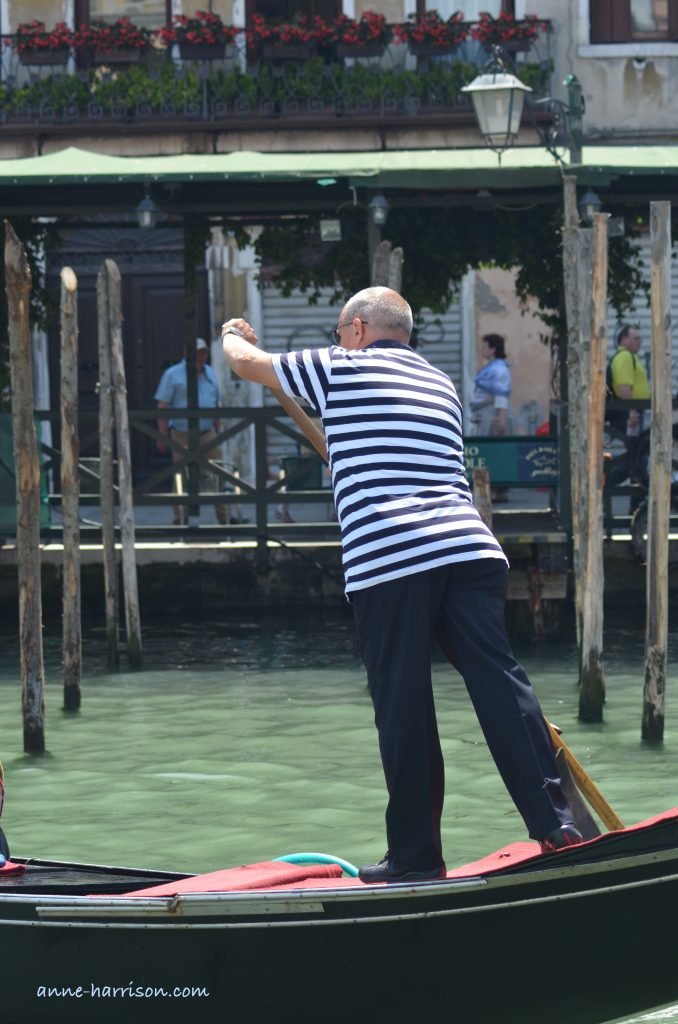Venice, Gondolas and Me
View to a gondola © A. Harrison
Well, my window
meets San Trovaso
things have ends and beginnings
Ezra Pound Cantos
A famed gondolier © A. Harrison
I've never been in one, yet I’ve always found gondolas incredibly romantic. I love the way they fearlessly bob up and down as they make their way along the Grand Canal between far larger boats, or hearing the slap of the water against their wood as they are tied up for the night.
When Ezra Pound arrived in Venice, he took rooms near a walled garden on the Rio San Trovaso, opposite a squero (or gondola building yard). Only a few now remain in Venice, although at the height of her powers some ten thousand gondolas served the city. The Squero di San Trovaso is still there, the oldest of the remaining squeri in Venice. It sits beside a small canal, the Rio de San Trovaso, in the Dorsoduro area of Venice. (I love staying in this part of Venice; it feels lived in, and there are less tourists per square inch than elsewhere in the city.)
The Squero di San Trovaso © A. Harrison
Although the Squero di San Trovaso is closed to the public, as the canal is only a few meters wide I could easily stand and watch from the other side as some half-dozen gondolas rested upside down in the outside square in various stages of repair. A few were being covered with black lacquer; seven coats are needed to give the boats their famous gloss. (Sumptuary laws passed in 1562, however, decreed all gondolas to be black to prevent ostentatious displays of wealth.)
Inside the shed another gondola was being built. (Less than a dozen new gondolas are made annually, each taking up to six months to complete.) Nine types of wood are used in construction, (elm, fir, walnut, oak, mahogany, larch, lime cherry and beech), from some 280 separate pieces, with much of the work still done by hand.
The boat-house and adjoining buildings of the squero are unusual for Venice, being made of wood, and adorned with geraniums. They are Tyrolean in style, for most squeraroli, (the artisans who work on the gondolas), originally came from this area in the Dolomites, where the best boat-building wood is still to be found.
Peak hour Venetian style © A. Harrison
The gondoliers’ knowledge of the canals is legendary, and rumour holds they are born with webbed feet, to help them walk on water. The history of the gondola is equally as romantic. They are first recorded in the Venetian annals in 1094, when Doge Vito Falier issued a charter allowing Venetian citizens to build their own gondolas (implying they were already in use.) Even the origin of the name is unclear, possibly being derived from the Latin cuncula (meaning shell) or cymbula (meaning a little boat).
Although the design has changed since the gondola first appeared, the manner of steering remains the same: the gondolier faces the bow and propels the boat with a forward stoke, followed by a compensating backward stroke. Originally, some gondolas had two oarsmen; one at the front and one at the stern, and occasionally this method is employed in the backwaters of Venice, as a novice is taught his craft.
Another time I walked by in the early morning light. I often rise with the dawn when travelling to walk the streets of a city, watching them come awake. I love how they change through the course of a day, often changing their personalities with the hour. A great way to discover a place like Venice. And to discover a gondola trying a u-turn in a tiny canal.
A gondola u-turn © A. Harrison
I continued along the Rio de San Trovaso, to the Fodamenta Zattere al Ponte Longo, that long quayside which looks over the Venetian Lagoon to the island of Giudecca. The wind was rising, and waves were licking the top of the quay. Outside the Santa Maria della Visitazione I saw a boccadi leone, a letterbox where anonymous denunciations were once made to The Great Council.
I found a place to sit, and ordered some coffee. The call of gulls filled the air, and the wind carried the smell of the sea. All manner of craft plied the waters before me, from vegetable barges to garbage trucks and even ambulances. Enormous ocean liners still pass through the lagoon, their wash flooding into the canals. I wondered how a gondolier would be able to control their gondola against a such a wash. But this is Venice, where gondolas and their striped-shirted gondoliers have been part of the city’s mythology for over one thousand years. In Venice they always find a way.
Waiting for gondolas on the Grand Canal © A. Harrison
The Literary Traveller
Ezra Pound’s Cantos are not for the faint-hearted. Consisting of 116 sections, or Cantos, it is considered by many one of the most significant works of modernistic poetry; Gertrude Stein, however, Gertrude Stein, on the other hand, mocked his obsessive need to insert his versions of history, thought, economics, and morality throughout his poetry.
Whatever your opinion, they are worthy companion to read whilst sipping a prosecco and watching the gondolas of Venice
Like my photos? - if you feel like contributing to my coffers, please click either here or on the link in my header to buy (or simply browse) my photos. Or else, please click here to buy either my poetry or novel ebooks. I even have a YouTube channel. Thank you!







